In the heart of Bali, where vibrant culture and culinary traditions intertwine, offering an authentic Balinese cuisine experience in your villa is more than just providing meals; it’s an opportunity to immerse your guests in the rich tapestry of Balinese heritage.
By showcasing the island’s culinary gems, you can elevate guest satisfaction, transform ordinary stays into unforgettable journeys, and cement your villa’s reputation as a haven of authentic Balinese hospitality.
Understanding Balinese Cuisine – A Culinary Journey
Balinese cuisine is a symphony of flavors, a harmonious blend of indigenous traditions, foreign influences, and the bounty of the island’s fertile lands.
It’s a cuisine that speaks to the heart and soul, a testament to the Balinese people’s deep connection to their culture and their land.
Influences from neighboring Indonesia, India, and China have mingled seamlessly with Balinese traditions, creating a culinary landscape of unparalleled diversity.
Key Ingredients and Flavors
The flavors of Balinese cuisine are bold and vibrant, reflecting the island’s lush tropical landscape.
Fresh herbs and spices play a starring role, infusing dishes with a symphony of aromas and tastes.
Rice: The staple food of Bali, rice is revered as a sacred gift from the goddess Dewi Sri. It is present in almost every meal, often served with a variety of side dishes.
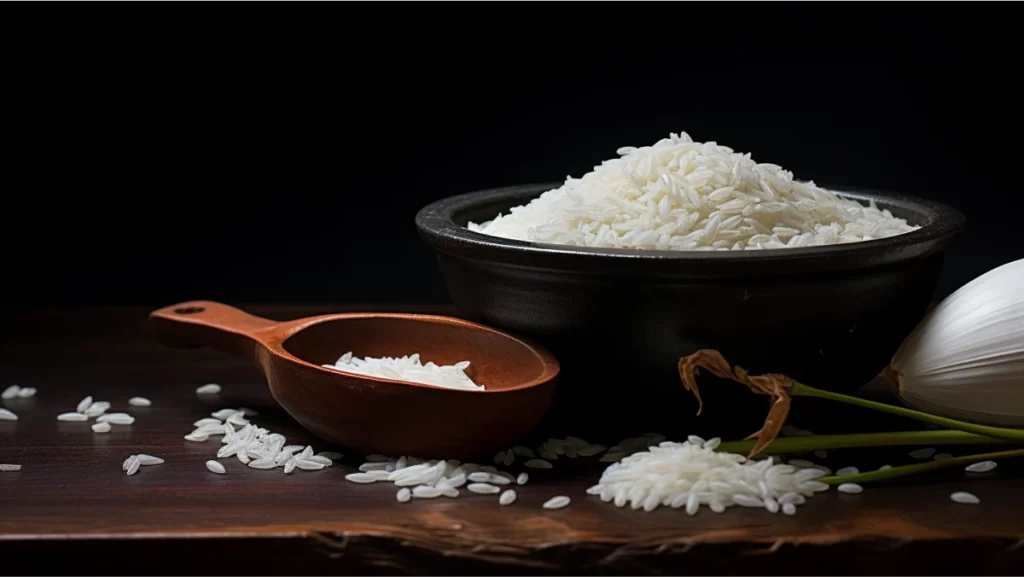
Meat and Seafood: Pork, chicken, duck, and seafood are commonly used in Balinese dishes, often marinated in flavorful spice blends and grilled or roasted.

Lemongrass: This fragrant herb is ubiquitous in Balinese cuisine, lending a citrusy-peppery zest to dishes.
Turmeric: This golden spice adds warmth and earthy notes, while also possessing anti-inflammatory properties.

Galangal: This pungent rhizome imparts a ginger-like flavor with a touch of citrus, deepening the complexity of Balinese dishes.
Chilies: The Balinese love for spice is evident in their generous use of chilies, adding a fiery kick that awakens the palate.
Coconut: This versatile ingredient is a staple in Balinese cuisine, used in its various forms – milk, cream, oil, and grated flesh – to add richness, sweetness, and a subtle nutty flavor.
Crafting a Culinary Journey for Your Guests
Curating a Balinese menu for your villa is an opportunity to showcase the island’s rich culinary heritage and impress your guests with an authentic taste of Bali.
Here’s some Balinese dishes that you can adapt to suit your guests’ preferences and the availability of local ingredients:
Appetizers
Lawar: A mixture of vegetables, coconut and minced meat mixed with rich herbs and spices.

Sate Lilit: Skewered, minced chicken or fish marinated in a rich spice paste, grilled to perfection. Can also be served as side dishes.
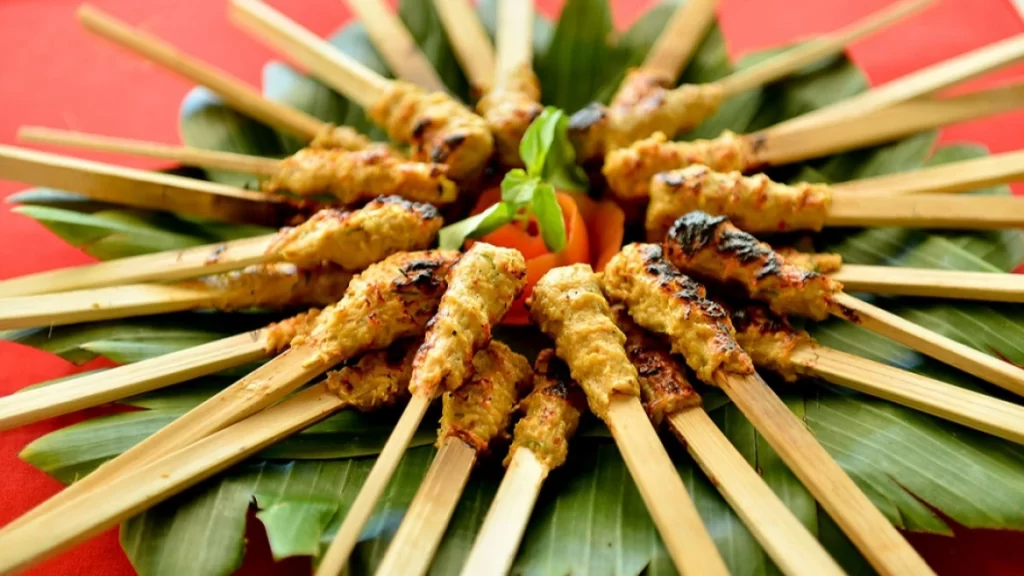
Rujak Manis: A refreshing salad of sweet and sour fruits, balanced by the spiciness of sambal.
Main Course
Nasi Campur Bali: A classic Balinese dish that consists of a variety of dishes served with rice, including lawar, sate lilit, sambal matah, and vegetables.
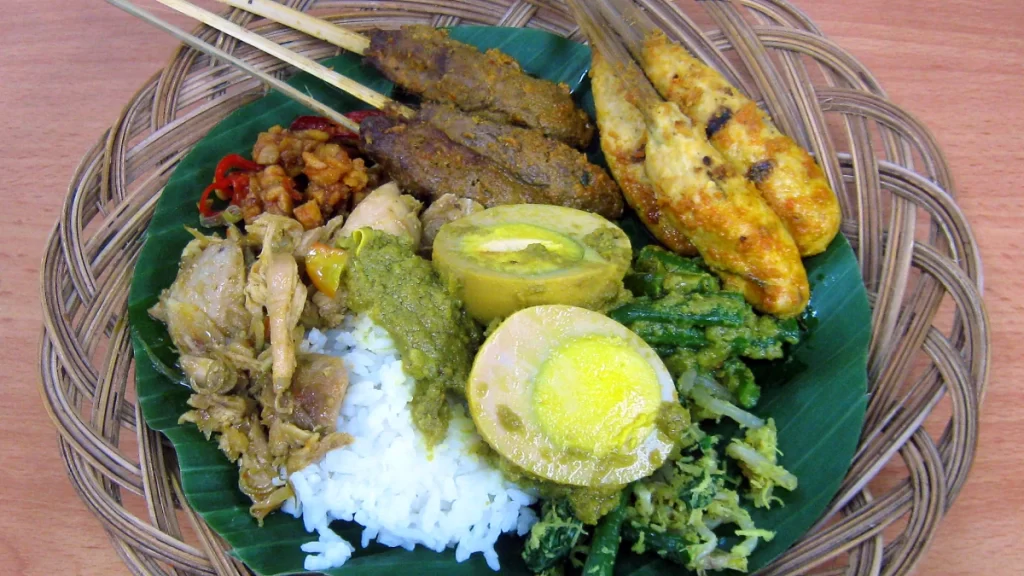
Babi Guling: Roasted pork dish that is a popular dish in Bali. The pork is marinated in a blend of spices and herbs, then roasted over a wood fire until it is crispy on the outside and tender on the inside.
Ayam Betutu: Traditional Balinese dish of chicken that is marinated in a blend of spices and herbs, then wrapped in banana leaves and cooked in a pit oven. The chicken is slow-cooked for hours, resulting in a tender and flavorful dish.

Mujair Nyat nyat: A Mujair fish that is fried or baked and has Balinese herbs and spices. Nyat nyat itself is a special process in Balinese cuisine to reduce the water from a dish.
Desserts
Klepon: Small rice cakes filled with palm sugar and coated in grated coconut. Klepon are soft, chewy, and sweet, and they are sure to please your guests.
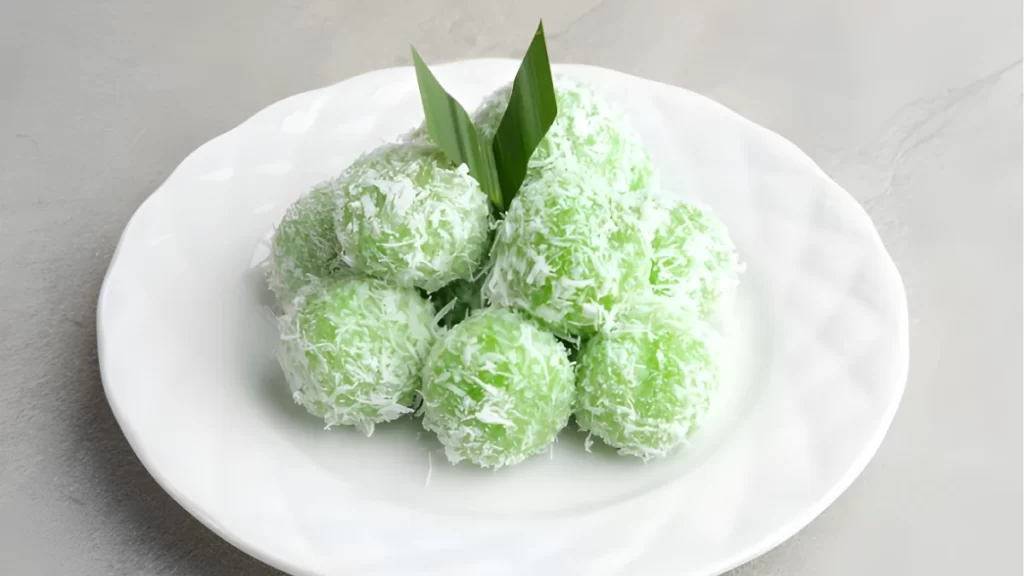
Batun Bedil: Batun Bedil is glutinous rice flour and starch shaped like a rifle bullet seed. After cooking, the Batun Bedil stew is mixed into brown sugar sauce that has been cooked with rice flour.
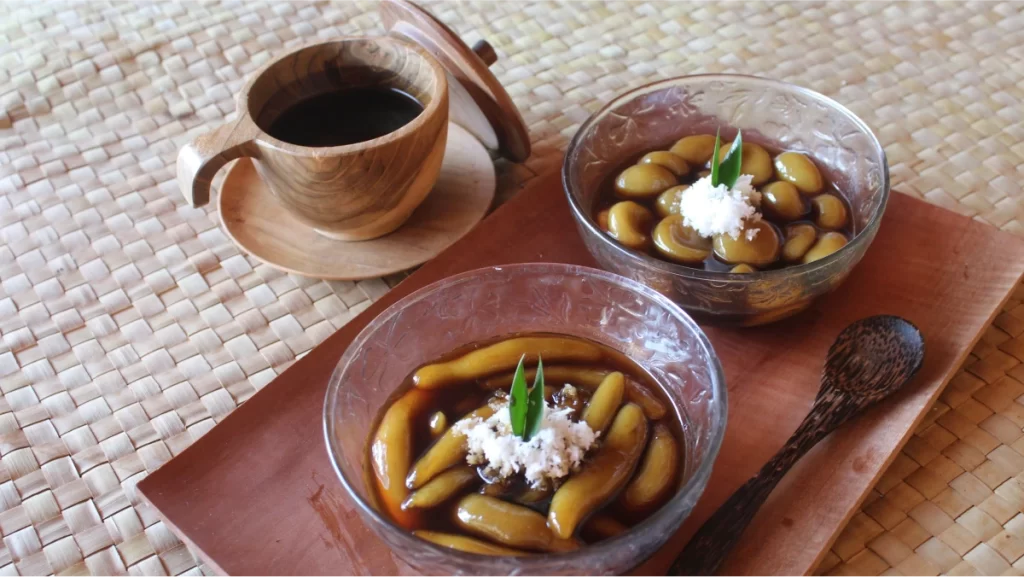
Laklak: Laklak are palm sugar dumplings that are popular in Bali. They are made from glutinous rice flour and are filled with palm sugar. Laklak are steamed until they are soft and chewy, and they are often served with grated coconut.
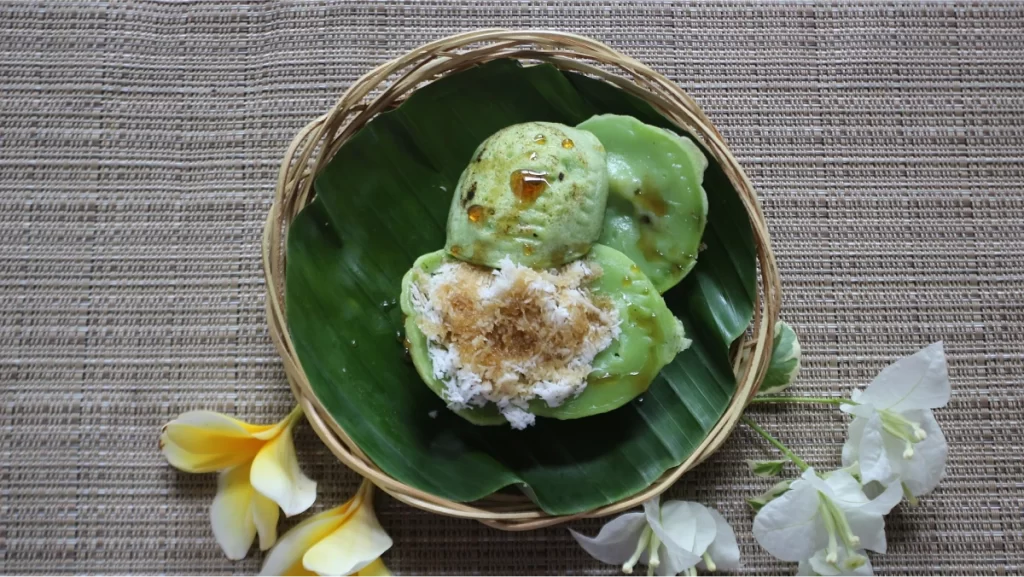
Creating A Balinese Dining Experience
After successfully designing a Balinese menu for your villa, now it’s time to continue to the next step …
Creating an authentic Balinese dining experience.
To truly immerse your guests in the island’s culinary culture, extend the Balinese ambiance beyond the kitchen and into the dining area.
Embrace Balinese Décor
Step into any traditional Balinese home, and you’ll be greeted by a warm and inviting atmosphere, characterized by natural materials, intricate craftsmanship, and a deep connection to nature.
To create a similar ambiance in your villa’s dining area, consider incorporating these elements:
Natural Materials: Opt for natural materials like rattan, bamboo, and wood for furniture and décor, creating a sense of harmony with Bali’s tropical surroundings.
Intricate Craftsmanship: Adorn the space with handcrafted Balinese artifacts, such as woven baskets, traditional masks, and intricately carved wooden figurines.
Tropical Touches: Bring the essence of Bali’s lush greenery indoors with potted plants, fresh flowers, and woven bamboo screens.
Serene Sounds and Sights
The Balinese dining experience extends beyond the taste buds, encompassing all the senses. To enhance the ambiance, consider incorporating traditional elements like:
Balinese Gamelan Music: The gentle sounds of Balinese gamelan music, a traditional ensemble of percussion instruments, can create a serene and harmonious atmosphere.
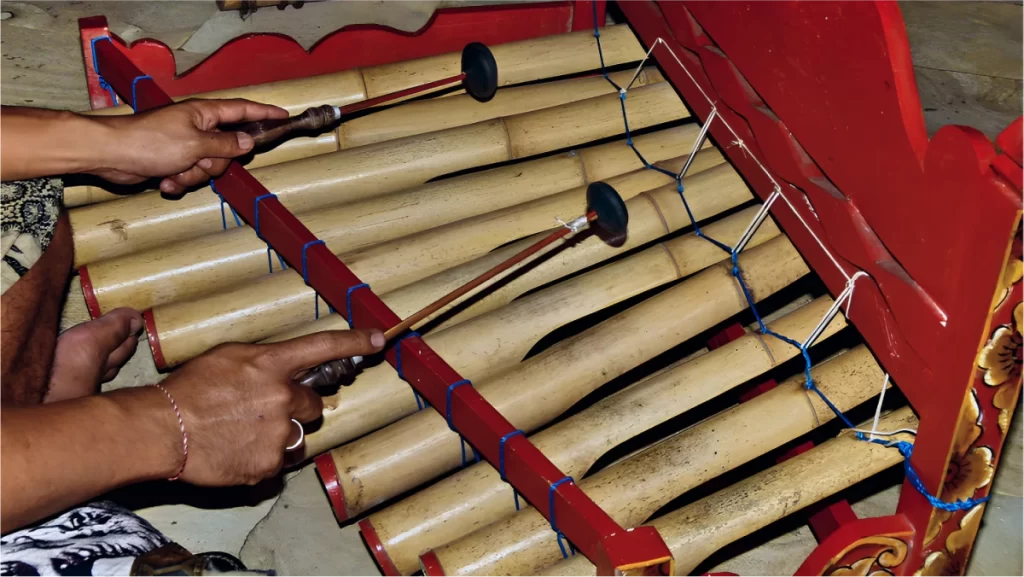
Balinese Warmness: Encourage your staff to wear neat and beautiful traditional Balinese clothes during the dinner to capture the essence of Balinese ambience around your guests atmosphere.
The Art of Setting and Presentation

In Balinese cuisine, presentation is an integral part of the dining experience. Elevate your guests’ culinary journey with these thoughtful touches:
Table Setting: Set the table with traditional Balinese placemats and tableware, adding a touch of authenticity to the dining experience.
Plating and Garnishes: Plate each dish with care, using colorful garnishes like fresh herbs, edible flowers, and carved fruits to enhance the visual appeal.
Serving Ware: Use traditional Balinese serving ware, such as woven baskets or wooden platters, to further immerse your guests in the Balinese culinary tradition.
Hosting Balinese Cooking Classes for Guests
Aside to dining experience, offering Balinese cooking classes within your villa is another exceptional way to enhance your guests’ experience, providing them with a hands-on immersion into the island’s rich culinary heritage.
It’s an opportunity to share your passion for Balinese cuisine, foster cultural connections, and create unforgettable memories that will last long after their stay.
To successfully host Balinese cooking classes at your villa, consider these essential steps:
Equipment and Supplies: Ensure your kitchen is well-equipped with the necessary utensils, appliances, and ingredients to support cooking classes.
Skill Level: Determine the skill level of your target audience and tailor your classes accordingly, offering beginner, intermediate, or advanced options.
Scheduling and Pricing: Establish a clear schedule for cooking classes, considering the availability of your guests and the length of their stay. Set competitive prices that reflect the value of the experience.
Collaboration with Local Experts: Seek out experienced Balinese chefs or reputable cooking schools in your area. Establish a mutually beneficial agreement that outlines responsibilities, revenue sharing, and marketing strategies.
Marketing and Promotion: Promote your cooking classes through your villa’s website, social media platforms, and local tourism channels. Collaborate with local travel agents and tour operators to reach a wider audience.
Showcasing Your Culinary Excellence to the World

Creating an authentic Balinese dining experience is just the first step; the next crucial step is to showcase this culinary gem to potential guests.
Effective marketing strategies will attract discerning travelers seeking an immersive and authentic Balinese experience.
1. Capture the Essence in Visual Storytelling
Hire a professional photographer to capture stunning images of your Balinese dining experience.
Focus on highlighting the ambiance, the presentation of dishes, and the joy on guests’ faces.
Share these images on your website, social media, and travel platforms to entice potential guests.
2. Harness the Power of Social Media
Create engaging social media content that showcases the Balinese dining experience.
Share mouthwatering photos of dishes, videos of cooking demonstrations, and testimonials from satisfied guests.
Engage with your audience by responding to comments and questions promptly.
3. Utilize Travel Platforms for Broader Reach
Use popular travel platforms like Airbnb, Booking.com, and TripAdvisor to reach a wider audience of potential guests.
Create detailed descriptions of your Balinese dining experience, highlighting the unique aspects and the cultural significance of the cuisine.
Encourage guests to leave reviews and testimonials on these platforms to enhance your credibility.
4. Leverage Influencer Marketing
Collaborate with food bloggers, social media influencers, and travel writers to promote your Balinese dining experience.
Invite them to experience your culinary offerings firsthand and encourage them to share their experiences with their followers.
This authentic and relatable content will reach a broader audience and generate excitement among potential guests.
5. Share Testimonials and Experiences
Positive reviews and testimonials from satisfied guests are powerful marketing tools.
Encourage guests to leave reviews on travel platforms and social media.
Share these testimonials on your website and marketing materials to build trust and credibility among potential guests.
Conclusion: Embracing Balinese Cuisine for a Remarkable Guest Experience
By incorporating this culinary heritage into your villa’s offerings, you’re not just satisfying palates; you’re immersing guests in the island’s vibrant cultural tapestry.
This culinary immersion elevates your villa beyond mere accommodation, transforming it into a sanctuary where guests can truly savor the essence of Bali.
An authentic Balinese culinary experience offers a multitude of benefits for your villa business:
- Enhanced Guest Satisfaction: Offering Balinese cuisine goes beyond serving food; it’s about providing an immersive cultural experience that guests will cherish long after their stay.
- Elevated Villa Reputation: By showcasing your commitment to authentic Balinese cuisine, you’re setting your villa apart from the competition, establishing a reputation for culinary excellence.
- Cultural Exchange: Balinese cuisine is a window into the island’s traditions and values. By sharing this culinary heritage, you’re fostering cultural exchange and promoting understanding among your guests.
- Additional Revenue Stream: Culinary experiences can serve as a valuable addition to your villa’s revenue stream, attracting new guests and enhancing the overall value proposition.
As you embark on this culinary adventure, remember that authenticity is key.
Partner with local chefs, source fresh ingredients, and present dishes in traditional Balinese style.
Let the flavors, aromas, and ambiance transport your guests to the heart of Balinese culture, creating a dining experience that is truly unforgettable.





